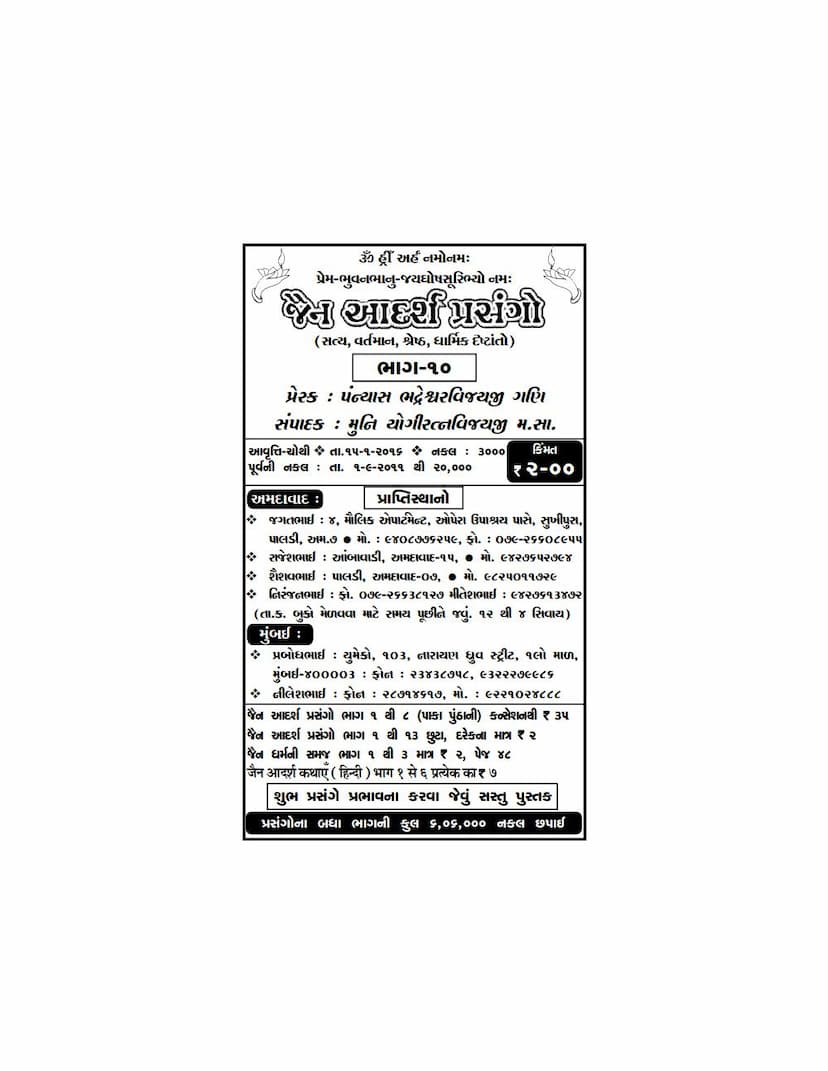Jain Adarsh Prasango Part 10
Added to library: September 1, 2025

Summary
The Jain text "Jain Adarsh Prasango Part 10" by Bhadreshwarvijay, edited by Muni Yogiratnavijayji, is a collection of inspiring anecdotes and exemplary stories from Jainism, intended to promote righteousness and spiritual understanding. Here's a comprehensive summary of its content:
Overall Theme and Purpose:
The book aims to highlight virtuous deeds, spiritual practices, and the transformative power of faith within the Jain tradition. It showcases how individuals, through their actions and devotion, achieve spiritual growth, overcome challenges, and exemplify the Jain way of life. The stories serve as moral lessons, encouraging readers to adopt similar positive qualities and practices.
Key Themes and Types of Stories:
The collection covers a wide spectrum of human experiences and spiritual aspirations, categorized by the following prominent themes:
-
Devotion to Deities and Gurus (Dev-Guru Bhakti): Many stories emphasize the importance of unwavering devotion to Jain Tirthankaras (Gods) and enlightened spiritual guides (Gurus). This includes stories of:
- Animals exhibiting devotion: A remarkable story describes a pigeon in Baroda that participates in daily Jain rituals like Samayika (meditation), listens to religious discourses, and even observes fasts. This highlights the deep spiritual potential across all living beings.
- Transformation through divine sight: A hunter, initially an atheist, is so profoundly moved by the compassionate gaze of Lord Simandhar Swami's idol that he abandons his violent profession and dedicates his life to the Lord.
- Service to Gurus in old age: The text praises Jain Sanghs (communities) for taking care of elderly monks and nuns, providing them with suitable accommodations and care when they can no longer travel (Vihar).
- Sacrifice for spiritual guides: A devotee builds an entire floor of her bungalow to provide a permanent residence for a Sadhvi (nun), demonstrating immense devotion.
-
Pious Deeds and Virtuous Conduct (Pious Deeds and Virtuous Conduct): The book celebrates acts of kindness, generosity, and adherence to Jain principles:
- Selfless acts of charity and kindness: Stories detail individuals helping others, even strangers, with genuine compassion and a desire to accumulate spiritual merit.
- Honesty and integrity in business: A businessman, after inadvertently receiving extra money in a transaction, seeks out the customer to return the amount, even offering him a job.
- Family devotion and care: A daughter-in-law donates a kidney to her father-in-law, showcasing filial piety.
- Renunciation of worldly pleasures for spiritual pursuits: The text praises individuals who prioritize religious austerities and vows over personal comfort and material gain.
-
The Power of Faith and Spirituality (The Power of Faith and Spirituality): The stories powerfully illustrate how faith can overcome adversity and bring about miraculous changes:
- The impact of prayer and chanting: Numerous accounts highlight the efficacy of chanting the Navkar Mahamantra, demonstrating its power to heal diseases, avert accidents, and provide solace during difficult times. One story recounts how a woman's unwavering faith and chanting saved her from a severe neurological condition.
- The importance of scripture study and knowledge: The establishment of Jain reading libraries and pathshalas (religious schools) for children is lauded, emphasizing the significance of acquiring spiritual knowledge.
- The concept of Karma and Rebirth: The story of Sevantibhai, who recalled his past lives with astonishing accuracy, reinforces the Jain belief in karma and reincarnation.
- The virtue of contentment and self-discipline: Stories emphasize the importance of controlling desires, practicing austerity, and living a life of simple contentment.
-
Commitment to Jain Principles: The book underscores the practical application of Jain ethics:
- Jivdaya (Compassion for living beings): The text promotes acts of compassion, such as rescuing animals, and discourages harm to any living creature. A story highlights a family that chose to use their son's birth celebration funds for animal welfare instead of traditional sweets.
- Ahimsa (Non-violence): This fundamental Jain principle is implicitly woven through many narratives, encouraging a lifestyle that minimizes harm to all sentient beings.
- Asteya (Non-stealing): The story of a thief returning stolen goods after receiving a simple invitation to dinner highlights the potential for change through compassion and understanding.
- Brahmacharya (Celibacy/Chastity) and controlled desires: The stories praise individuals who observe strict vows related to celibacy and control their sensual desires.
-
Community and Sangha Spirit: The importance of collective effort and mutual support within the Jain community is also a recurring theme.
Notable Anecdotes (Examples):
- The Devoted Pigeon: This story (Page 3) is a prime example of how even animals can exhibit profound spiritual inclination when exposed to righteous practices.
- The Hunter's Transformation: (Page 4-5) This narrative vividly illustrates the power of divine darshan (seeing the divine) to bring about a radical change of heart.
- The Daughter-in-law's Kidney Donation: (Page 6) A touching story of selfless sacrifice and family devotion.
- The Businessman's Integrity: (Page 8-9) The story of Seth Maneklal Chunilal exemplifies honesty and generosity, even when dealing with a thief.
- The Power of the Navkar Mantra: Several stories, particularly on pages 44-48, showcase the miraculous effects of chanting the Navkar Mahamantra for healing, protection, and spiritual solace.
- The Dedicated Student: The establishment of a "Free Jain Reading Library" (Page 13-15) and the dedication of students who utilize it demonstrate a commitment to education and spiritual learning.
- The Ascetic Family: The story of Mahendrabhai and Minakshiben's extensive austerities and vows (Page 38-40) is a testament to their extreme devotion and spiritual discipline.
- The Question that Sparked Change: A son's innocent question about his parents' dietary habits leads to a profound shift in their lives (Page 23-26).
Overall Impact:
"Jain Adarsh Prasango Part 10" serves as a guide and inspiration for Jains and anyone interested in spiritual living. It demonstrates that by embracing Jain principles, cultivating devotion, and engaging in virtuous actions, individuals can lead a meaningful life, attain spiritual progress, and contribute positively to society. The book is written in Gujarati, making the inspiring stories accessible to its primary audience.